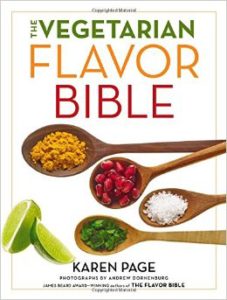Vegetarian Flavor Bible by Karen Page.

If you’ve never had an encounter with Karen Page’s Flavor Bible, then with The Vegetarian Flavor Bible, you’re in for a real treat. It’s a comprehensive listing of vegetables, fruits, herbs, spices, dairy, eggs for their nutritional profiles and Page’s brand, “flavor matchmaking”—something she’s perfected that summarizes each ingredient in all its glorious attributes.
The Vegetarian Flavor Bible categorizes each ingredient for its nutritional density (high, medium, or low). Then follow several categories for flavor and technique. For instance, “Beans, Cannellini” is given a high density rating, and is matched with artichokes, basil, bay leaf, carrots, celery, chard, escarole, garlic, kale, lemon, olive oil, tomatoes, vinegar, and many more lesser known to capitalize on cannellini’s smooth texture. In the list are also types of cuisines which the bean is suited to, especially Italian, and types of dishes, such as pastas, stews, dips. Page’s “Flavor Affinities” is the final list in which cannellini beans are featured, so there are cannellini beans plus basil plus tomatoes; or cannellini beans plus chard plus garlic plus olive oil plus rice plus vinegar; or cannellini beans plus beet greens plus walnuts.
The book sets out to advertise the marvelous array of flavors and pairings that are possible with this food group, a fact that cannot really be attained by cooking meat and then choosing vegetables to garnish. As Page says, a vegetable becomes the “meat” of a dinner, and the variety and richness is infinite!
Why own this book? Two reasons: one is because Karen Page and Andrew Dornenberg (author and photographer) put together this book after living the vegetarian lifestyle (and liking it). And second, because there’s nothing like having as much knowledge as possible about flavor combinations at your right hand. And in this book they are the whole subject. It’s true, much of the listings and texts would be considered “for the record”—as in, ‘in 2014 they believed this about vegetables and fruits’. Who knows, in the future we indeed may need to be reminded about natural tastes—especially when in the future our food becomes even more prescribed and manufactured than it is today.
Follow


